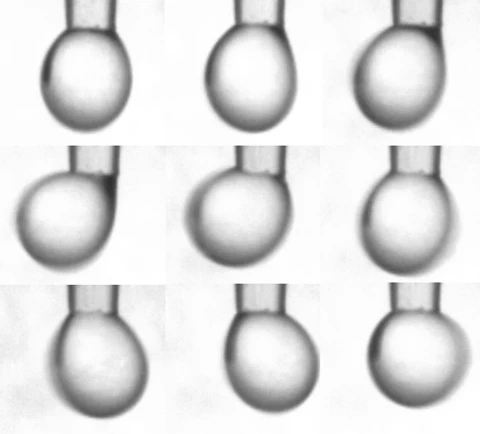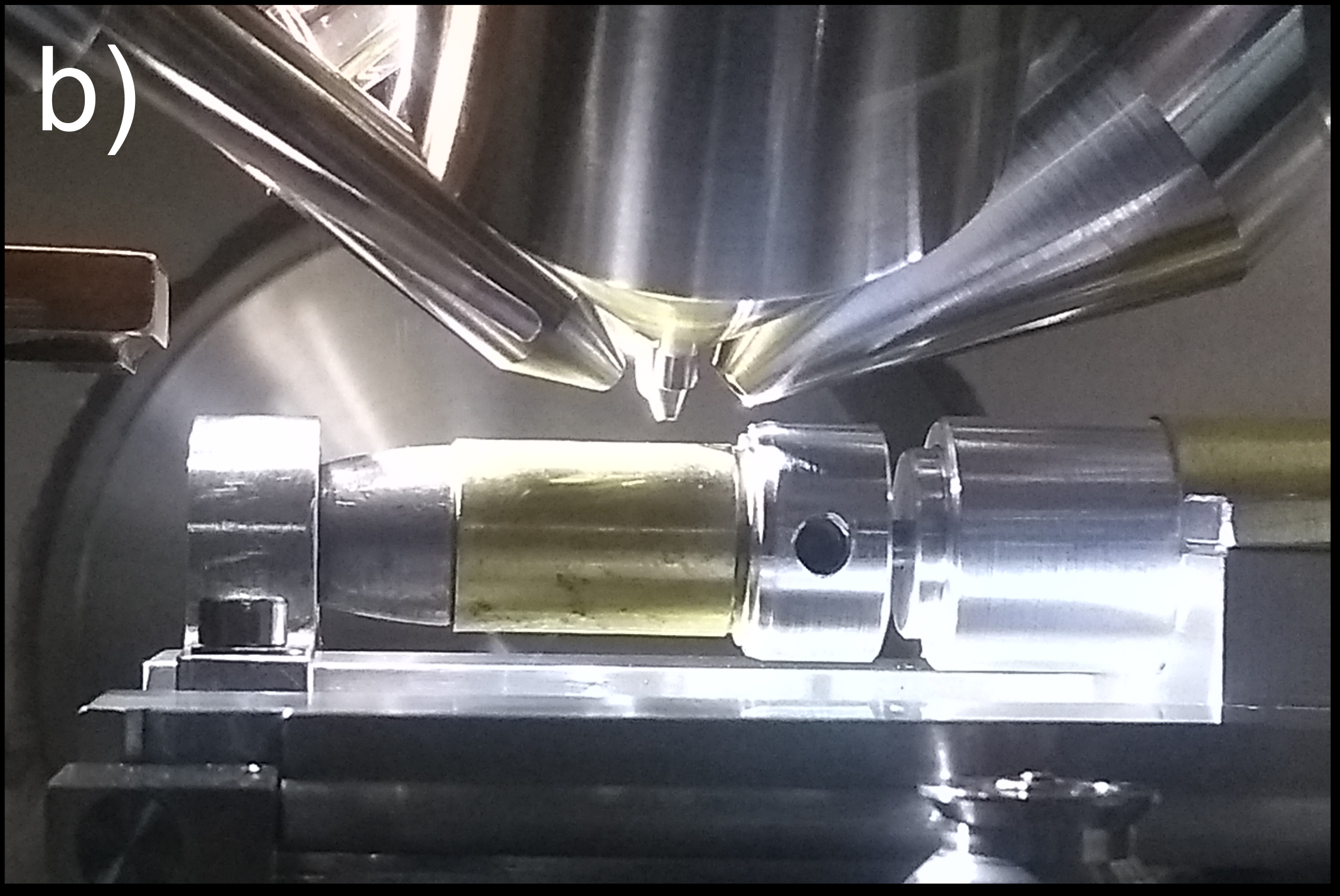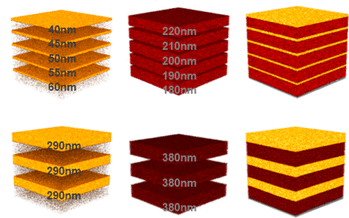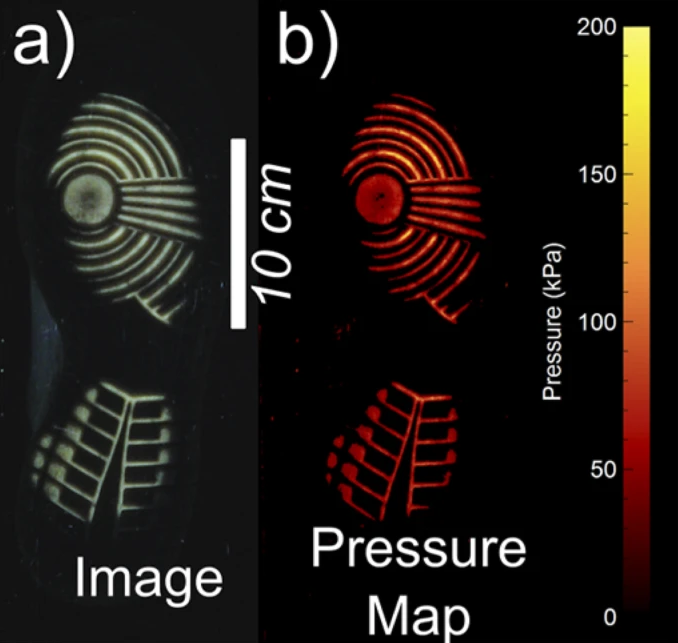School of Physics and Astronomy, University of Nottingham
Projects
Mechanical Vibration of Thin Films, Droplets and Bubbles

Mechanical vibrations of films, drops and bubbles can be used to probe their physical properties. In ultrathin films (thickness <100 nm) we use a novel piezoelectric actuation and acoustic detection technique to probe the tension and mechanical properties of free standing polymer membranes. Our work on drops and bubbles uses laser deflection and high speed movies of droplets to extract information about surface tension, viscosity and/or viscoelastic properties.
Telephone Cord Blister Formation and the Failure of Interfaces

Telephone cord blisters form during the failure of the adhesive forces between a film and a substrate. When the strain energy (areal) density caused by in-plane stresses exceeds the work of adhesion, the film can buckle away from the substrate to form a one-dimensional wrinkle in the film. However, this leaves un-relaxed stress in the film perpendicular to the axis of the wrinkle and secondary buckling can occur - giving rise to the characteristic sinusoidal telephone cord blister shape. Our work aims to study the rich physics of these buckling phenomena and the growth rates of the telephone cord structures. We are particularly interested in studying film thickness effects and the role of lateral film confinement on stress fields.
Wrinkling and Pattern Formation in Thin Films and Multi-layers

The differential response to an external field (mechanical stress, swelling, electric) of one or more layers in a multi-layer sample has a tendency to drive a buckling instability when the mismatch in stresses in the layers exceeds a critical value. When the multi-layer structure is thick, or bonded to a substrate it is impossible for the entire structure to buckle and this often leads to localised wrinkling of the surface of the sample. Our work aims to understand the physics of the buckling instabilities that are driven by solvent swelling, applied mechanical loads and changes in interfacial roughness between layers. In particular, we are interested in studying how the wavelength and amplitude of the wrinkling instabilities can be controlled by varying the thickness of the layers in the sample and the magnitude of the applied fields. This work has potential application for the production of self-assembled diffraction gratings, substrates for cell culture and for the creation of surfaces to prevent biofouling.
Fluidic Levitation
Bubbles and droplets can be made to levitate in a more dense fluid when it is forced downward through a tube or channel. When the fluid velocity is equal and opposite to the critical velocity of the buoyant drop or bubble, the object remains stationary in the frame of reference of an external observer. Fluid flow in the tube or channel has the effect of distorting the drop/bubble shape. We are interested in understanding how these shape distortions occur in viscous and visco-elastic fluids. We also study the role of surfactants and the interactions of multiple drops in the fluid channels.
Retrieval of Fingermarks from Bullet Casings and Other Challenging Surfaces

Extracting fingermarks from bullet casings is very difficult. This is particularly true if a bullet has been fired from a gun, where the surface experiences extremes of heat, pressure and friction while also being subject to contamination from gunpowder residue. We have developed a novel sample rotation stage that allows us to perform Time of Flight Secondary Ion Mass Spectrometry (ToF SIMS) measurements on curved surfaces. The sub-monolayer sensitivity of ToF SIMS has enabled us to extract fingermarks from bullet casing surfaces where conventional techniques fail to produce any marks.
This work has also been covered in the media.
Polymer Multilayer Structures for GHz-THz Acoustic and Photonic Applications

Spin cast multi-layers of aternating polymer layers are used to produce structures with periodic spatial variations in optical and mechanical properties. When sufficent optical contrast exists between the layers and their thickness values lie in the ~100 nm range, it is possible to produce mirrors (distributed Bragg reflectors, DBRs) that reflect light of specific wavelengths. This is done using optically uninteresting materials such as polystyrene and polyvinylpyrollidone and the wavelengths of interest can be tuned simply by varing the thickness of the layers. We have succesfully created DBRs that reflect both visible and infrared wavelengths using this approach.
When the layers have contrast in their mechanical properties then it is possible to confine sound waves within these structures. If individual layer thickness values fall within the ~10 nm range then the multi-layers display interesting properties in the GHz-THz frequency ranges. Devices based upon these multi-layers have potential applications in telecommunications.
Optical Methods for Imaging Contact Area and Forces

Frustrated total internal reflection (FTIR) of visible light or infrared wavelengths is used to image the contact regions between soft objects and a hard planar waveguide surface. This technique can also be used to measure the pressure distribution beneath a soft contacting object. Our work uses FTIR to perform high speed imaging of pressure distributions beneath sports shoes, as well as developing applications for improving breast cancer surgery and in the forensic imaging of fingerprints and footwear.
